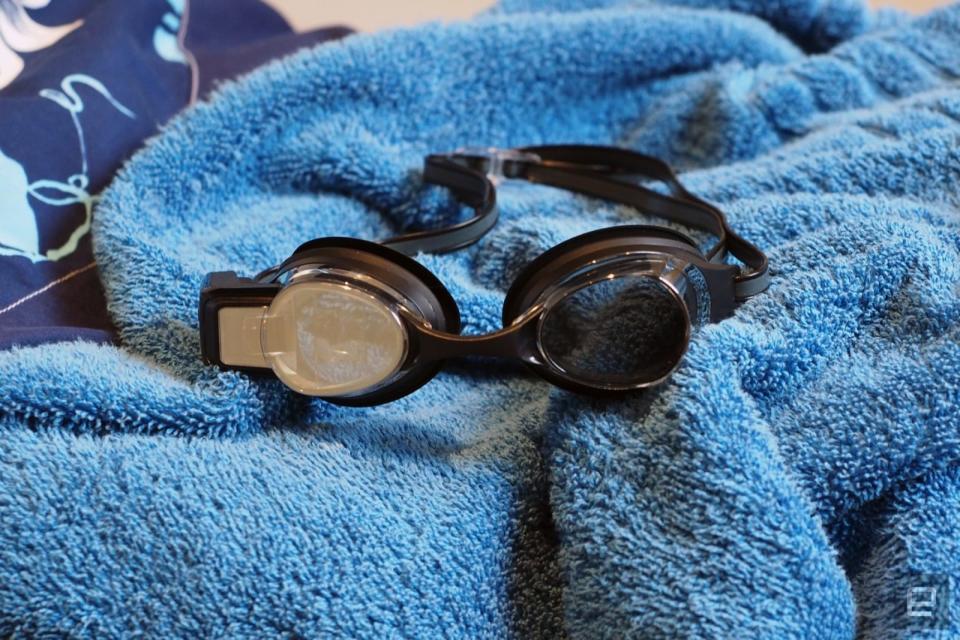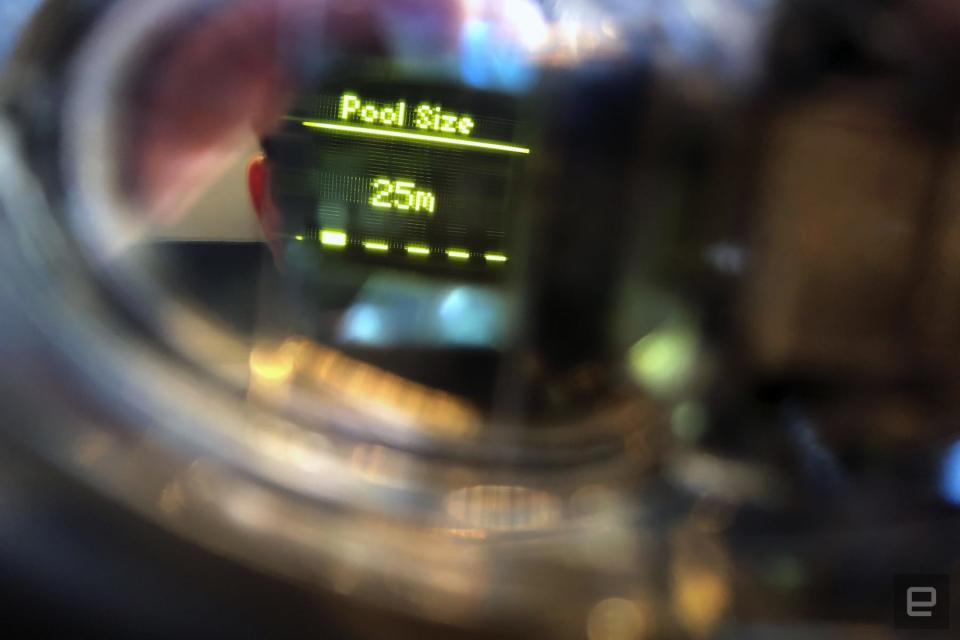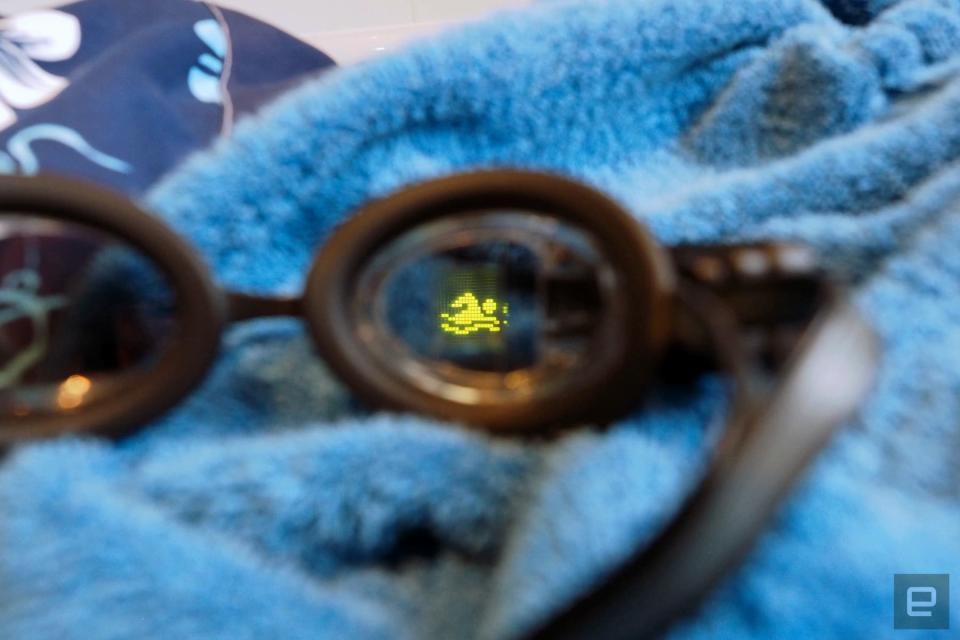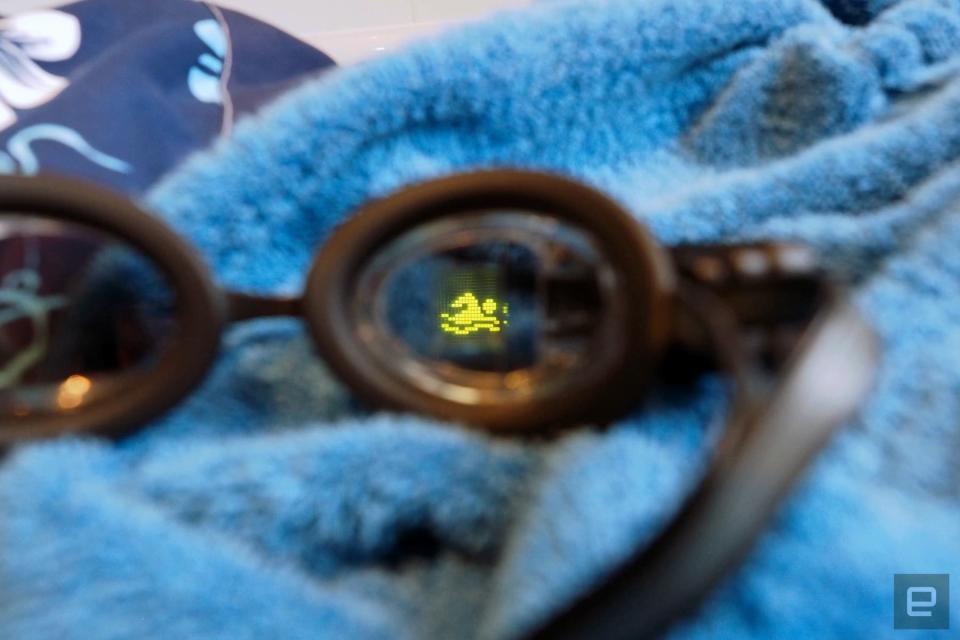Form's Swim Goggles are the first great wearable for swimmers
Subtle but powerful.
What you're looking at sells why you'd ever want a pair of Form's new Swim Goggles more than any spec sheet or press release. Its transparent display sits over one of your eyes, serving up real-time stats about how well you're swimming, including your times, distances and splits. This is the same kind of data you see on TV during the Olympics, but now you're the superstar worthy of tracking. And it's all beamed straight to your face.
You could reductively call Form's goggles: "Google Glass, but for swimmers" but the comparison doesn't work. For one thing: Form made something so inconspicuous that nobody noticed them when I tested them out in my local pool. And if you didn't know about the pricey anti-scratch and anti-fog lens coatings, you'd easily mistake them for a pair of mid-tier swimming goggles.
It's only when you're up close and personal that you notice that something is different. Specifically, there's a little crystal inside one of the lenses for a waveguide display. This is powered by a small box that sits just outside the lens mount. The hardware is small and light, containing nothing but the waveguide, gyroscope and a battery, rated for 16 hours on a single charge. The only other noticeable feature is two silver pins on the outside, for connecting to the USB charging cable.
Form designed the goggles to work on either eye, you just need to turn them over (and flip the display orientation). I used them with the lens on my right, which put the two hardware buttons (power and selection) on the underside of the box. Because there are only two buttons, you'll need to paw through a couple of carousel menus for setup, but even that only takes a minute or two.
Head to a pool and the only thing you need to do is tell the goggles the width of the pool you're jumping in to. There are pre-selected options for the most common sizes, 25 meters, 25 yards, 50 meters or 50 yards, or the option for a custom size. You pick if you're planning to do laps or drills, and you're ready to swim, in the care of the system and its algorithms, designed to detect your swimming style.
These algorithms were created internally by Form. It worked with a number of swimmers, from amateurs through to Canada's Olympic swim team. Each subject did laps in the water, with gyroscopes strapped to their heads, while being filmed from a number of angles. The video and movement data were then mashed together to create the patterns the goggles use to intuit your movement.
One thing you're told not to do is dip the lenses in pool water to demist them, but I am a creature of habit. Fortunately, the anti-fog coating ensured that I only needed to wipe them down twice in almost an hour. And the waveguide remained easy to see, since the yellow text color was chosen to stay visible through water.
In my experience, those swim detection algorithms worked pretty well, although the nature of the system meant that there were the odd miscalculation -- especially when I slowed down your swim to avoid a divebombing teen. Or a pair of grown-ass adults who stopped to chat in the middle of a swim lane.

For company founder Dan Eisenhardt, this marks the culmination of a 13-year journey to build a sports wearable. "I've been a competitive swimmer all my life," he said, "and [back in 2006] thought, why can't I see my split [times] while I was swimming?"
This was shortly before the Nike+ Foot Pod would, arguably, launch the modern quantified self movement. In an MBA class on entrepreneurship, he was asked to pitch an idea he was passionate about, but "hadn't prepared anything." Off the cuff, he began talking about his frustration about the lack of swim data, and people in the class paid attention.
Eisenhardt and some classmates at the University of British Columbia would initially explore the idea of a swimming wearable. Sadly, someone found a patent that seemed to relate to the idea, and they, in their naiveté, chose not to pursue it. Instead, they planned to build heads-up display for another category of sport altogether: skiing. The company they would go on to form would be Recon Instruments.
Long before Google Glass, Recon was making heads-up displays for snowsports, teaming up with big brands like Oakley. Then in 2015, the company launched the Recon Jet, a pair of smart sunglasses for cyclists and runners, which offered real-time data to help people shave seconds from their time. Intel would buy the company soon after, as part of its doomed push into wearables. It shut Recon down just two years later.
"As soon as we sold to Intel, I knew I had another [project] in me," said Eisenhardt. His frustrations around swimming hadn't changed, even after the explosion in wearables. "You can't [stop to] read your watch while swimming," he said "and swimmers don't want to wear a watch, because it interferes." He feels that even the bulky Garmin Eisenhardt wears for triathlons is inadequate to the task of keeping him informed in the water.
Unlike other novice companies building their initial hardware product, Form's wearable is only technically its first. After all, this is a team that, under the Recon Instruments and Intel names, has produced "five generations of smart glasses," said Eisenhardt. And the team knew "the traps [they] had to avoid," when it came to building a (potentially) mass-market product like this. Investors, too, were willing to pony up $8 million to fund the company so far.
I tested the Recon Jet back in 2015, saying that the smart glasses had the "potential to be better." In part, that was because the device cost $700 and tried to be a platform, rather than a tool designed for a specific job or hobby. It was ostensibly designed for runners and cyclists, but could also run third-party apps and had a 2.1-megapixel camera. In trying to be all things to all people, it failed to do any of those jobs well enough to make it an essential purchase.
By comparison, Form's Swim Goggles are a focused product that does one job very well. It tracks your swimming and relays those stats to your eye as you swim, and that's it. The focus means that it's got no unnecessary extra features, it weighs very little and its battery lasts for ages. And that means a lot for capable swimmers, who don't want to carry around bulky devices that could hurt their times in the water.

I'm not, by any stretch, a regular or capable swimmer, but it was easy to see the value of Form's goggles in the water. When I hit my first 25 meters and turned around, the display flashed how long it took me to do the lap. From then, I was determined to shave seconds from that time, although it was hard to navigate around the rowdy teens in the pool.
But as the kids got bored and left, my times began to improve, going from 50 seconds to 48, 47, and then 40. For one glorious lap, it was 38 seconds and I was pushing myself to swim even faster, not caring that my heart was racing. I'm itching to go back and have another go. I'm even watching YouTube tutorials to see how I can improve my form.
I talked about the goggles to some of the more experienced swimmers in the pool, and let them complete a couple of laps with them. The overall impression was that they'd like to own such a device, since they, too, didn't like swimming with watches. Another said that the goggles were "like something out of Robocop," which was meant as a compliment.
The companion app for iOS and Android is akin to a mini Strava or Facebook, letting you see detailed data on your swims, and what your friends are up to. That includes being able to view sets, overall duration, overall distance, calories burned and their SWOLF score. There's a wonderful feeling of being able to jockey for position and compete against other folks in your feed -- currently, mostly Form employees. You also get integrations with Strava and TrainingPeaks, as well as the ability to pull data from Garmin Connect.
In the 2009 US Census, more than 50 million people said that they swam "regularly," defined as more than six times a year. Form believes that there are around 30 million active pool swimmers in the US, and plenty more around the world. It only needs to convince a fraction of those that, if they want to learn about their swimming, then they should shell out for these goggles.

One thing that I find annoying about swimming is that, even as an amateur, there's very little structure to it. Unlike rowing or cycling, where you can set targets for speed and distance, I often just aimlessly swim up and down the lanes until I feel like I've done enough exercise. Form helps quantify and clarify how we're doing in the pool, meaning even rank amateurs can benefit from it.
Of course, if you're a semi-serious swimmer, or a member of the #marginalgains crowd, then the benefits are obvious. It may not be the same as a professional swimming coach or some hardcore equipment, but for $199, it's likely to be a damn sight cheaper.
The Form Athletica Swim Goggles are available to buy worldwide as of right now at Form's website.


